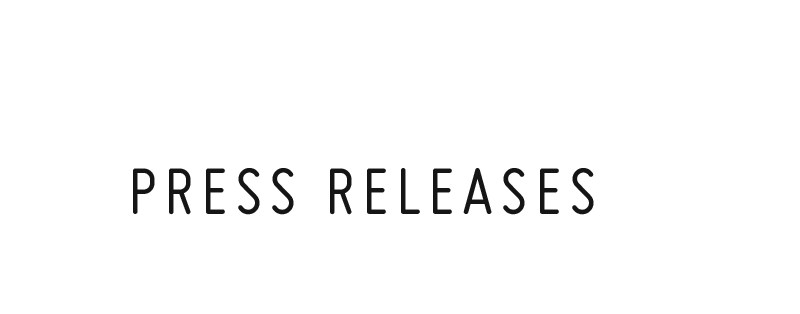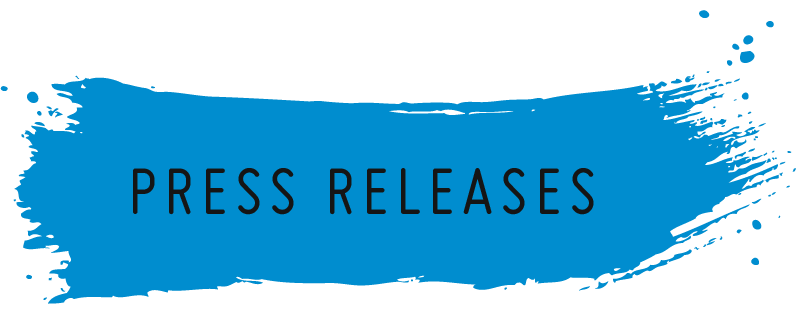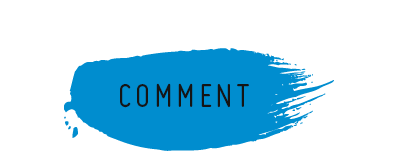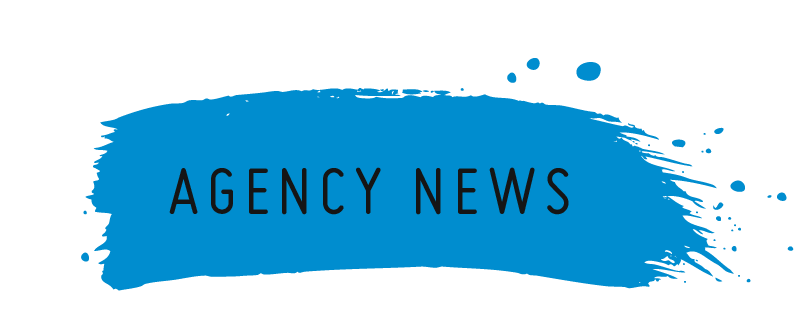- 3D Print Bureau
- 6K
- Agmatix
- Airwayz
- AM-Flow
- Appadda
- Caracol
- CG Trader
- CyberOptics
- e-Xstream
- GenCell
- GreenEye
- Impossible Objects
- Incus Media
- InkBit
- ITG
- JPB Systeme
- KeyProd
- Landa
- LEO Lane
- Lumet
- Magic Software
- MakerBot
- Marketiger
- Nano Dimension
- Paragon Rapid Technologies
- PearlX
- Plant & Bean
- Redefine Meat
- Replique
- Ripples
- Sakuu Corporation
- SolarEdge
- StoreDot
- Stratasys
- Sunrock
- The Bespoke Group
- Trigo
- UltiMaker
- Xjet
CREATING NEW POSSIBILITIES FOR ADDITIVE MANUFACTURING, STRATASYS REMOVES COMPLEXITY FROM DESIGN-TO-3D PRINT PROCESS
Advanced FDM Software designed to eliminate CAD-to-STL roadblock, streamlining workflow, production times, material usage – aimed at speeding time-to-market and revenue
SOLIDWORKS World, Dallas, TX, USA, February 11th, 2019 – Empowering designers and engineers to embrace new 3D printed possibilities, Stratasys (NASDAQ: SSYS) is further removing complexity from design-to-3D print processes. GrabCAD Print’s Advanced FDM feature is aimed at ensuring design intent via intuitive model interaction to rapidly deliver strong, light, and purpose-built parts.
By avoiding laborious CAD-to-STL conversion, users are able to work in high fidelity and rapidly advance the design-to-3D print process– which can lead to boosting both time-to-market and time-to-revenue. Advanced FDM is designed to speed part production, while maintaining creation of purpose-built parts that minimize weight without compromising strength.
“For design and manufacturing engineers, one of the most frustrating processes is ‘dumbing down’ a CAD file to STL format – only to require subsequent re-injection of design intent into the STL printing process,” said Mark Walker, Lead Software Product Manager at Stratasys. “This software is engineered to do away with this complexity, letting designers reduce iterations and design cycles – getting to a high-quality, realistic prototype and final part faster than ever before.”
With rich CAD-native build controls, the solution doesn’t require manual generation of complex toolpaths – cutting overall programming times for 3D printing. Intuitive features achieve desired part characteristics through automatic control of FDM build attributes. Engineers easily select areas on native design geometry and specify design attributes – letting Advanced FDM automatically calculate 3D print toolpaths.
“GrabCAD Print Advanced FDM’s geometry-based workflows have allowed us to fine-tune part builds – meeting application requirements and process parts more quickly than we could before,” said Robert Heath, Additive Manufacturing Application Engineer at Eckhart. “The seamless transition of moving a build between applications is easy and intuitive.”
Assigning attributes directly to CAD models, users pinpoint areas of strength and rigidity, control infills, ensure sufficient material around holes with inserts, and avoid seams. Since toolpaths are automatically generated from model assignments, the user can expect to spend significantly less time on part setup, without losing strong, high-quality, purpose-built FDM parts.
“Advanced FDM has proved invaluable in improving our part processing time. When processing a very large number of tools and fixtures in a very time pressured environment, it was crucial to ensure stronger tool areas were correct first time, every time,” said Dave Hewitson, Rapid Prototyping Programmer at McLaren. “Advanced FDM negates the requirement for multiple programs – creating a more streamlined process. It’s also allowed us to more effectively control the structure of end-use car parts, something that was previously very difficult with the solutions we had in hand. This means we can get better parts to the track faster.”
GrabCAD’s Advanced FDM is available now via download with GrabCAD Print (from versions 1.24) and is supported on the following Stratasys 3D printing systems: F370, Fortus 380mc, Fortus 380mc Carbon Fiber Edition, Fortus 450mc, Fortus 400mc, Fortus 900mc, and F900.
Learn more about the power of GrabCAD and Advanced FDM and the power of Stratasys by visiting: https://grabcad.com/print/features or https://www.stratasys.com/software
-
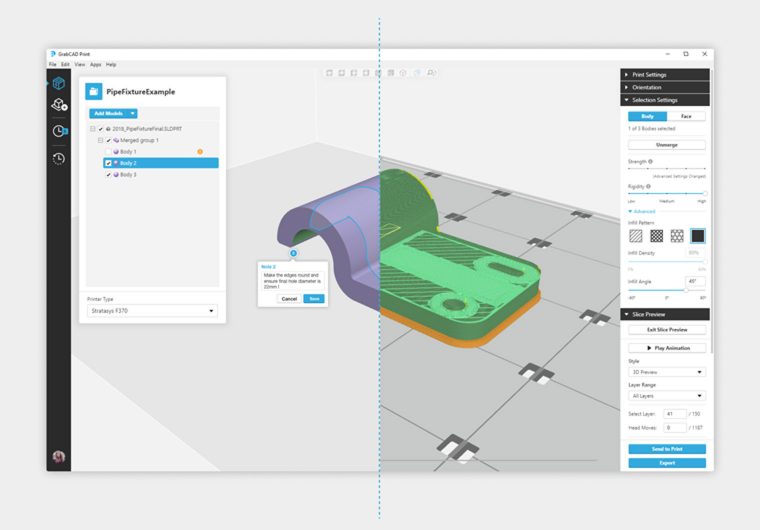 GrabCAD Advanced FDM eliminates the CAD-to-STL conversion process – creating new possibilities for designers and engineers with 3D Printing
GrabCAD Advanced FDM eliminates the CAD-to-STL conversion process – creating new possibilities for designers and engineers with 3D Printing
Click here to download 300dpi images -
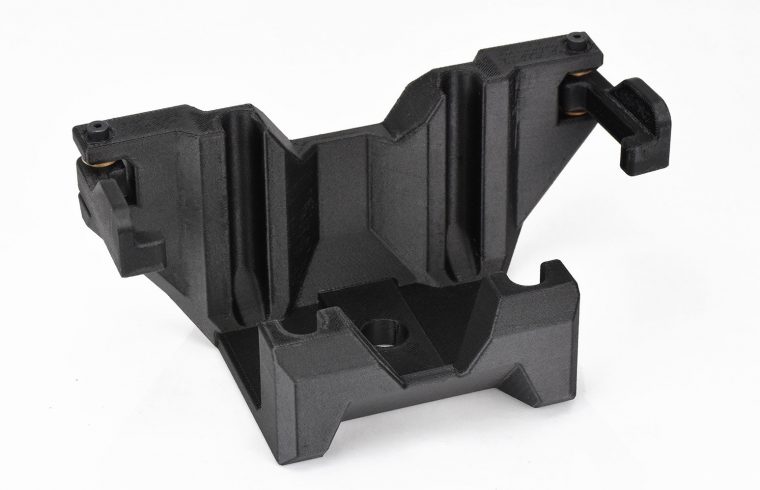 Leaf spring U-bolt fixture, customized using GrabCAD Advanced FDM from Stratasys
Leaf spring U-bolt fixture, customized using GrabCAD Advanced FDM from Stratasys
Click here to download 300dpi images
EN CRÉANT DE NOUVELLES POSSIBILITÉS POUR LA FABRICATION ADDITIVE, STRATASYS ÉLIMINE LA COMPLEXITÉ DU PROCESSUS DE LA CONCEPTION À L'IMPRESSION 3D
Logiciel avancé pour la technologie FDM conçu pour éliminer les obstacles liés à la transformation des fichiers CAO en STL, en rationalisant le flux de travail, les temps de production et l’utilisation du matériel, en vue d’accélérer les délais de commercialisation et d’augmenter les revenus
SOLIDWORKS World, Dallas, TX, États-Unis, 12 février 2019 – En permettant aux concepteurs et aux ingénieurs d’exploiter les nouvelles possibilités de l’impression 3D, Stratasys (NASDAQ: SSYS) réduit plus encore la complexité des processus allant de la conception à l’impression 3D. La fonctionnalité Advanced FDM de GrabCAD Print permet de rester fidèle aux objectifs de conception grâce à une interaction intuitive avec chaque modèle, et de fabriquer rapidement des pièces robustes, légères et répondant exactement au but recherché.
Par l’élimination de la phase laborieuse de conversion des fichiers CAO en STL, les utilisateurs sont en mesure de travailler avec une grande précision et de faire rapidement progresser le processus allant de la conception à l’impression 3D, pour ainsi améliorer les délais de commercialisation, et augmenter les revenus. Advanced FDM est conçu pour accélérer la production de pièces répondant exactement au but recherché, avec une réduction de poids ne compromettant en rien leur résistance.
« Pour les ingénieurs de conception et de fabrication, l’une des parties les plus frustrantes du processus consiste à décomposer les fichiers CAO au format STL, juste pour s’assurer de bien prendre en considération la conception originale dans le processus d’impression STL. », affirme Mark Walker, chef de produits logiciels chez Stratasys. « C’est un logiciel qui a été conçu pour éliminer cette complexité. Il permet aux concepteurs de réduire le nombre d’itérations et la durée des cycles de conception, et d’obtenir des prototypes et des pièces finales réalistes, de haute qualité, plus rapidement que jamais. »
Grâce à ses contrôles intégrés au format natif CAO, la solution n’a pas besoin d’intervention manuelle pour créer des trajectoires complexes, ce qui permet de réduire globalement les délais de programmation pour l’impression 3D. Ses fonctions intuitives permettent de conférer aux pièces les caractéristiques souhaitées grâce à un contrôle automatique des attributs de fabrication via technologie FDM. Les ingénieurs peuvent sélectionner aisément les différentes zones de la géométrie native afin de préciser les attributs de conception, et finalement laisser Advanced FDM calculer automatiquement les trajectoires d’impression 3D.
« Les flux de travail basés sur la géométrie que nous autorise la fonctionnalité Advanced FDM de GrabCAD Print nous ont permis d’affiner la fabrication des pièces, et de répondre aux exigences des applications tout en réalisant les pièces plus rapidement qu’avant. », déclare Robert Heath, ingénieur des applications de la fabrication additive chez Eckhart. « La transition d’une application à l’autre est à la fois simple et intuitive. »
En appliquant directement des attributs aux modèles CAO, l’utilisateur peut définir les zones de résistance et de rigidité, contrôler les trames de remplissage, prévoir suffisamment de matériau autour des orifices avec des inserts, et éviter les coutures. Dans la mesure où les trajectoires des outils sont automatiquement générées à partir des attributs sur les modèles, l’utilisateur peut s’attendre à consacrer beaucoup moins de temps à la phase de configuration, sans renoncer à la fabrication de pièces FDM résistantes, de haute qualité et répondant exactement au but recherché.
« Advanced FDM s’est avéré être un outil d’une valeur incalculable pour réduire le temps de fabrication de nos pièces. Lorsqu’il s’agit de fabriquer un très grand nombre d’outils et de fixations dans un environnement où le temps est un facteur décisif, il est essentiel de s’assurer que les zones d’outils les plus robustes sont correctes du premier coup, et à chaque fois. », explique Dave Hewitson, programmeur de prototypage rapide chez McLaren. « Advanced FDM évite d’avoir à utiliser différents programmes, créant ainsi un processus plus rationalisé. Il nous permet également de contrôler plus efficacement la structure des pièces automobiles finales, ce qui était auparavant très difficile avec les solutions que nous avions à notre disposition. Cela signifie que nous pouvons mettre plus rapidement en application des pièces de meilleure qualité. »
La fonctionnalité Advanced FDM de GrabCAD est désormais disponible en téléchargement avec GrabCAD Print (à partir de la version 1.24), et est compatible avec les systèmes d’impression 3D Stratasys suivants : F370, Fortus 380mc, Fortus 380mc Carbon Fiber Edition, Fortus 450mc, Fortus 400mc, Fortus 900mc et F900.
Pour en savoir plus sur la puissance de GrabCAD, Advanced FDM et Stratasys, n’hésitez pas à visiter : https://grabcad.com/print/features ou https://www.stratasys.com/software
-
 En éliminant le processus de conversion des fichiers CAO en STL, la fonctionnalité Advanced FDM de GrabCAD ouvre de nouveaux horizons aux concepteurs et ingénieurs utilisant l'impression 3D
En éliminant le processus de conversion des fichiers CAO en STL, la fonctionnalité Advanced FDM de GrabCAD ouvre de nouveaux horizons aux concepteurs et ingénieurs utilisant l'impression 3D
Click here to download 300dpi images -
 Fixation de ressort à lames personnalisée grâce à la fonctionnalité Advanced FDM de GrabCAD, de Stratasys
Fixation de ressort à lames personnalisée grâce à la fonctionnalité Advanced FDM de GrabCAD, de Stratasys
Click here to download 300dpi images
NEUE MÖGLICHKEITEN FÜR DIE ADDITIVE FERTIGUNG - MIT STRATASYS IST DER PROZESS VOM ENTWURF BIS ZUM 3D-DRUCK GANZ UNKOMPLIZIERT
Die Software Advanced FDM macht die aufwendige Umwandlung von CAD in STL überflüssig, optimiert Arbeitsabläufe, Produktionszeiten und Materialverbrauch – und beschleunigt so die Markteinführungszeiten und den Umsatz
SOLIDWORKS World, Dallas, TX, USA, 13. Februar 2019 – Designer und Ingenieure können jetzt die neuen Möglichkeiten des 3D-Druck für sich nutzen – Stratasys (NASDAQ: SSYS) gestaltet den Prozess vom Entwurf zum 3D-Druck jetzt noch unkomplizierter. Die GrabCad Print Funktion ‘Advanced FDM’ soll gewährleisten, dass der Entwurfsansatz über eine intuitive Interaktion mit dem Modell schnell in stabile, leichte und speziell angefertigte Bauteile umgesetzt werden kann.
Durch den Verzicht der arbeitsintensiven Umwandlung von CAD in STL können Anwender in hoher Genauigkeit arbeiten und den Prozess vom Entwurf zum 3D-Druck schnell weiterentwickeln – was zu einer Verkürzung der Markteinführung und Umsatzrendite führen kann. Advanced FDM ist darauf ausgelegt, die Fertigung von Bauteilen zu beschleunigen, ohne dabei auf die Herstellung speziell angefertigter leichtgewichtiger Bauteile zu verzichten oder Abstriche in der Festigkeit machen zu müssen.
„Für Industriedesigner und Fertigungsfachkräfte ist das „Herunterformatieren“ einer CAD-Datei in STL-Format einer der frustrierendsten Prozesse – alles nur um anschließend den Entwurfsansatz in den STL-Druckprozess erneut eingeben zu müssen“, sagt Mark Walker, Lead Software Product Manager bei Stratasys. „Diese Software wurde entwickelt, um diesen komplizierten Vorgang zu vermeiden, damit Designer Iterationen und Designzyklen reduzieren können – und schneller als je zuvor zu einem hochwertigen, realitätsgetreuen Prototyp oder Endprodukt gelangen.“
Dank umfangreicher, in CAD eingebundener Konstruktionssteuerungen erübrigt sich die manuelle Generierung komplexer Werkzeugwege und verkürzt die gesamte Programmierungszeit für den 3D-Druck. Durch intuitive Funktionen werden die gewünschten Eigenschaften der Bauteile über eine automatische Steuerung der FDM-Bauattribute erreicht. Die Ingenieure können Bereiche mit systemeigenen Design-Geometrien auswählen und Designattribute festlegen – so kann Advanced FDM automatisch die 3D-Druck-Toolpaths berechnen.
„Die geometriebasierten Workflows von GrabCAD Print Advanced FDM haben es uns ermöglicht, die Bauteilfertigung zu verfeinern – so können wir Anwendungsanforderungen besser erfüllen und die Bauteile schneller verarbeiten”, sagt Robert Heath, Additive Manufacturing Application Engineer bei Eckhart. „Der nahtlose Übergang bei der Übermittlung zwischen den Anwendungen ist einfach und intuitiv.“
Durch die direkte Zuordnung von Attributen in den CAD-Modellen werden Zähigkeit- und Festigkeitsbereiche festgelegt, Kontrolle über Hohlräume gewährleistet, ausreichend Material um die Aussparungen herum sichergestellt und Nähte vermieden. Da die Werkzeugwege automatisch aus Modellzuweisungen generiert werden, kann der Anwender mit deutlich weniger Zeitaufwand bei der Bauteileinrichtung rechnen, ohne dabei auf stabile, hochwertige und speziell angefertigte FDM-Bauteile verzichten zu müssen.
„Advanced FDM hat sich für die Verkürzung unserer Produktionszeit für Bauteile als unbezahlbar herausgestellt. Bei der Bearbeitung einer großen Anzahl von Werkzeugen und Vorrichtungen unter hohem Zeitdruck war es von wesentlicher Bedeutung, robuste Werkzeugbereiche auf Anhieb gewährleisten zu können“, sagt Dave Hewitson, Rapid Prototyping Programmer bei McLaren. „Mit Advanced FDM wird dieAnforderung an mehrere Programme überflüssig und es wird ein besser optimierter Prozess geschaffen. Zudem ermöglicht es uns eine effektivere Kontrolle der Struktur der endgültigen Fahrzeugbauteile. Das war mit den Lösungen, die wir bisher zur Verfügung hatten, sehr schwierig. Das bedeutet, dass wir bessere Bauteile schneller auf die Rennstrecke bekommen.“
GrabCad Print Advanced FDM ist ab sofort als Download über GrabCAD Print (ab Version 1.24) verfügbar und wird von den folgenden 3D-Drucksystemen von Stratasys unterstützt: F370, Fortus 380mc, Fortus 380mc Carbon Fiber Edition, Fortus 450mc, Fortus 400mc, Fortus 900mc und F900.
Weitere Informationen über die Leistungen von GrabCAD und Advanced FDM sowie Stratasys finden Sie unter: https://grabcad.com/de/print/features oder https://www.stratasys.com/de/software
-
 GrabCad Print Funktion 'Advanced FDM' macht den Umwandlungsprozess von CAD in STL überflüssig – und schafft so mithilfe von 3D-Druck neue Möglichkeiten für Designer und Ingenieure
GrabCad Print Funktion 'Advanced FDM' macht den Umwandlungsprozess von CAD in STL überflüssig – und schafft so mithilfe von 3D-Druck neue Möglichkeiten für Designer und Ingenieure
Click here to download 300dpi images -
 Blattfeder mit Bolzen-Schraubverbindung, angepasst mit GrabCAD Print Advanced FDM von Stratasys
Blattfeder mit Bolzen-Schraubverbindung, angepasst mit GrabCAD Print Advanced FDM von Stratasys
Click here to download 300dpi images
CREANDO NUOVE POSSIBILITÀ PER LA FABBRICAZIONE ADDITIVA, STRATASYS RIMUOVE LA COMPLESSITÀ DAL PROCESSO DI PROGETTAZIONE FINO ALLA STAMPA 3D
Software FDM avanzato, progettato per eliminare gli ostacoli da CAD a STL, semplificando il flusso di lavoro, i tempi di produzione, l’uso dei materiali, con l’obiettivo di velocizzare il time-to-market e il ritorno economico
SOLIDWORKS World, Dallas, TX, USA, 13 febbraio 2019 – Con l’obiettivo di consentire a progettisti e ingegneri di abbracciare le nuove possibilità della stampa 3D, Stratasys (NASDAQ: SSYS) sta ulteriormente rimuovendo la complessità dai processi dalla progettazione alla stampa 3D. La funzionalità FDM avanzata di GrabCAD Print mira a garantire l’intento del progetto tramite l’interazione intuitiva con il modello per fornire rapidamente parti robuste, leggere e create appositamente.
Evitando la conversione da CAD a STL, un processo molto laborioso, gli utenti sono in grado di lavorare in alta fedeltà e velocizzare il processo dalla progettazione alla stampa 3D, con conseguente miglioramento del time-to-market e dei tempi di ritorno economico. La tecnologia FDM avanzata è progettata per rendere più rapida la produzione delle parti, mantenendo al contempo la creazione di parti personalizzate che riducono al minimo il peso senza compromettere la resistenza.
“Per i tecnici della progettazione e della produzione, uno dei processi più frustranti consiste nella “trasformazione” di un file CAD nel formato STL, al solo scopo di richiedere il successivo reinserimento dell’intento progettuale nel processo di stampa STL”, ci racconta Mark Walker, responsabile principale dei prodotti software di Stratasys. “Questo software è studiato per abbandonare la complessità, facendo in modo che i progettisti riducano iterazioni e cicli di progettazione, in modo da ottenere un prototipo realistico di alta qualità e una parte finale con una rapidità mai sperimentata in precedenza”.
Grazie ai potenti controlli CAD nativi, la soluzione non richiede la generazione manuale di percorsi di lavorazione complessi, tagliando così i tempi complessivi per la stampa 3D. Le funzionalità intuitive consentono di ottenere le caratteristiche desiderate per le varie parti mediante il controllo automatico degli attributi di costruzione FDM. Gli ingegneri selezionano con semplicità le aree sulla geometria di progettazione nativa e specificano gli attributi di progettazione, lasciando che la tecnologia FDM avanzata calcoli automaticamente i percorsi di lavorazione della stampa 3D.
“I flussi di lavoro basati sulla geometria della tecnologia FDM avanzata di GrabCAD Print ci hanno permesso di ottimizzare le creazione delle parti rispettando le esigenze applicative e di lavorare le parti in modo più rapido di quanto fosse possibile in precedenza”, spiega Robert Heath, ingegnere per le applicazioni di fabbricazione additiva di Eckhart. “La transizione di un lavoro da un’applicazione all’altra è semplice e intuitiva”.
Grazie alla possibilità di assegnare gli attributi direttamente ai modelli CAD, gli utenti possono determinare le aree di forza e rigidità, controllare i riempimenti, garantire la presenza di materiale sufficiente intorno ai fori con inserti ed evitare le giunzioni. Dal momento che i percorsi di lavorazione vengono generati automaticamente dalle assegnazioni dei modelli, gli utenti possono prevedere una riduzione dei tempi di configurazione delle parti FDM, senza comprometterne le caratteristiche di robustezza, qualità elevata e personalizzazione.
“La tecnologia FDM avanzata ha dimostrato un valore incalcolabile nel miglioramento dei tempi di lavorazione delle parti. Nella lavorazione di un numero elevatissimo di strumenti e attrezzature in ambienti in cui il tempo rappresenta una pressione notevole, era fondamentale garantire che le aree degli strumenti più resistenti fossero corrette dal primo momento” spiega Dave Hewitson, programmatore per la prototipazione rapida di McLaren. “La tecnologia FDM avanzata nega la necessità di programmi multipli, creando un processo più semplice. Ci ha consentito inoltre di controllare con maggiore efficacia la struttura delle parti di uso finale delle auto, cosa che in precedenza era molto difficile con le soluzioni di cui disponevamo. Ciò significa che possiamo ottenere parti migliori in tempi più rapidi”.
La tecnologia FDM avanzata di GrabCAD è ora disponibile tramite download con GrabCAD Print (dalle versioni 1.24) ed è supportata sui seguenti sistemi di stampa 3D Stratasys: F370, Fortus 380mc, Fortus 380mc Carbon Fiber Edition, Fortus 450mc, Fortus 400mc, Fortus 900mc, e F900.
Per saperne di più sulla potenza di GrabCAD e della tecnologia FDM avanzata di Stratasys visita: https://grabcad.com/print/features o https://www.stratasys.com/it/software
-
 La tecnologia FDM avanzata di GrabCAD elimina il processo di conversione da CAD a STL creando nuove possibilità per progettisti e tecnici con la stampa 3D
La tecnologia FDM avanzata di GrabCAD elimina il processo di conversione da CAD a STL creando nuove possibilità per progettisti e tecnici con la stampa 3D
Click here to download 300dpi images -
 Elemento a U per balestra personalizzato mediante la tecnologia FDM avanzata di GrabCAD di Stratasys
Elemento a U per balestra personalizzato mediante la tecnologia FDM avanzata di GrabCAD di Stratasys
Click here to download 300dpi images
STRATASYS SIMPLIFICA EL PROCESO DEL DISEÑO A LA IMPRESIÓN 3D Y ABRE ASÍ NUEVAS POSIBILIDADES PARA LA FABRICACIÓN ADITIVA
Advanced software for FDM technology designed to eliminate the obstacle of converting CAD into STL and optimize workflow, production times and the use of material in order to accelerate time to market and increase revenue
SOLIDWORKS World, Dallas, Texas, USA UU., February 12, 2019 By enabling designers and engineers to take advantage of the new possibilities of 3D printing, Stratasys (NASDAQ: SSYS) continues to eliminate the complexities of the workflow from design to 3D printing. The purpose of GrabCAD Print’s Advanced FDM function is to guarantee design intent by intuitively interacting with the model to quickly create resistant, lightweight and specialized parts.
By avoiding the painstaking process of converting CAD into STL, users can work with great precision and move quickly from the design process to 3D printing, which can accelerate time to market and increase revenue. The Advanced FDM function has been designed to speed up the production of parts, while maintaining the creation of specialized parts that weigh less but remain very resistant.
“Uno de los procesos más frustrantes para los ingenieros de diseño y fabricación es la conversión del archivo CAD en formato STL, solo para tener que reinyectar posteriormente la intención de diseño en el proceso de impresión STL”, comenta Mark Walker, principal responsable de productos de software de Stratasys. “Este software se ha diseñado para terminar con esta complejidad de forma que los diseñadores puedan reducir las iteraciones y los ciclos de diseño, y así conseguir prototipos y piezas finales realistas y de gran calidad más rápido que nunca”.
By having integrated controls in the native CAD format, the solution does not require the manual generation of complex toolpaths, which reduces the overall programming timeframes for 3D printing. Its intuitive functions allow to obtain the desired characteristics of the pieces thanks to an automatic control of the construction attributes through the FDM technology. Engineers easily select areas of the native design geometry and specify design attributes so that Advanced FDM will then automatically calculate the 3D printing toolpaths.
“The workflows based on the geometry that makes possible the Advanced FDM functionality of the GrabCAD Print software have allowed us to adjust the manufacturing of parts, meet the requirements of the application and make parts faster than ever,” said Robert Heath , additive manufacturing applications engineer at Eckhart. “The transition from one application to another is simple and intuitive.”
By directly assigning attributes to CAD models, the user can detect areas of resistance and rigidity, control fillings, ensure the existence of sufficient material around the holes with inserts and avoid joints. As the toolpaths are generated automatically from the model assignments, the user spends much less time configuring the part without giving up the manufacture of resistant, specialized and high quality FDM parts.
“Advanced FDM has proven to be a very valuable solution when it comes to reducing the processing time of parts. When we had to process a large number of tools and fasteners with very tight deadlines, it was essential to ensure that the most resistant tool areas were correct the first time, always, “says Dave Hewitson, McLaren’s rapid prototyping programmer. “With Advanced FDM you do not need several programs, so the process is more agile. It has also allowed us to control more effectively the structure of the end-use parts of the car, something that was very difficult with the solutions we had previously handled. This means that our cars have better parts in less time. “
The GrabCAD Advanced FDM solution can be downloaded already with GrabCAD Print (as of version 1.24) and can be used with these Stratasys 3D printing systems: F370, Fortus 380mc, Fortus 380mc Carbon Fiber Edition, Fortus 450mc, Fortus 400mc , Fortus 900mc and F900.
Learn more about the potential of GrabCAD and Advanced FDM, and the possibilities offered by Stratasys by visiting: https://grabcad.com/es/print/features or https://www.stratasys.com/es/software
-
 GrabCAD Advanced FDM elimina el proceso de conversión de CAD en STL, lo que abre la puerta a nuevas posibilidades para los diseñadores e ingenieros en el ámbito de la impresión 3D
GrabCAD Advanced FDM elimina el proceso de conversión de CAD en STL, lo que abre la puerta a nuevas posibilidades para los diseñadores e ingenieros en el ámbito de la impresión 3D
Click here to download 300dpi images -
 Fijación con perno en U para ballesta, personalizada mediante GrabCAD Advanced FDM de Stratasys
Fijación con perno en U para ballesta, personalizada mediante GrabCAD Advanced FDM de Stratasys
Click here to download 300dpi images
